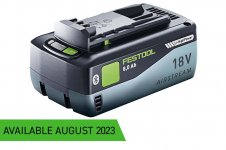Coen said:
All 3100 mAh 18650's are relatively low-power in the continuous discharge department. Simple function of the tradeoff between capacity and max. current.
TLDR:
Oh, if only it was that "simple".
Then the cell vendors would not need to be asked for 4-axis (current, voltage, charge, temperature) graphs of cell properties when designing anything that is pushing the cells to the limit.
Not saying pack design is magic, it is not. But the capacity and rated current are only very superficial characteristics. Enough to classify a cell type/class from a given maker or to choose one for vaping. Way insufficient to rate/choose a cell type for a demanding application like the one in a powertool.
----------------------------------
4.0 at 21700 size is equivalent to about 2.7 Ah at 18650 size. In that you are correct that one shall not expenct (much) more current out of the 6.2 packs as they have it harder => need higher class cells while the 5.2 can get bty with pretty standard stuff. AND the price of the packs reflects this. FT was even giving the 5.2s away at times while the 6.2 were never even available with tools. Cue: FT gets much worse margins on the 6.2s than the 5.2s. The first are a niche product with low margin. The latter and 4.0 are their cash cows.
As for what cells I would expect in the 6.2s (not having one around to check), my bet would be on below 6.5C ones, or a bit better:
https://www.18650batterystore.com/products/sony-vtc6?sscid=c1k6_10zc06&
20A sustained means a pack can do 40A. Now, while the 21700 cells are rated to 45A, and so give higher nominal current, that is ONLY WHEN COOLED. And herein comes the problem. You cannot sustain 40+A on a cell in a pack without active cooling. Nada. The same you cannot sustain 30A on a 18650 without cooling either. Not to mention the voltage drop is huge at those currents. So that is way outside the usable range for a power tool.
In practice, this means that the 10-cell 6.2s, will be
practical at higher pack currents than the 4.0 HP are. Simply because they have more volume to absorb the heat being generated. Also, beware that this needs full-characteristic analysis.
But suffice to say that FT is definitely not using low-drain cells in their 6.2 packs. The cells there are top-of-the-line ones basically. Of a higher class (and price) compared to the 4.0 cells in the HP packs.
The 4.0 is a 5.2 of the 21700 range. I very much expect FT to come with 10.0 packs down the line a few years later which will take the place of the 6.2s of today. I.e. the top-of-available-tech pack.
Ah and last point:
Every major battery vendor will sell you cells which are NOT available for general purchase - if you are willing to pay. If you pay, you can get select cells with better characteristics than the "general avalible" models. When they make the cells there is certain variance and the can up-sell the top cells to those who pay.
Such cells do not have different markings than the series they are from but will still be better (up to 5%). Not saying FT went this way with the 6.2s. But that is how the market works. Especially in aerospace and other high-end trades this is not unusual.
Similar like you can buy tuned grades of processors for your cloud farm - if you buy them in the 1000s and are willing to pay the premium.
Last comment on this:
A 30A rated cell means *you can safely take 30A from it without cell damage*. It does not say anything about the internal resistance - aka the voltage drop (and heat generation) when you do so. And it says absolutely nothing about the voltage drop at 50% of the rated current at 50% capacity, which is one's main concern for a power tool cell.
Aka, you can have below scenario:
2.5Ah cells, 20A rated, at 10A load at 50% capacity it can sustain 3.5 volts.
2.0Ah cells, 30A rated, at 10A load at 50% capacity it can sustain 3.3 volts.
See the "issue" ?
Actually, above effect of a different internal resistance characteristic is what, in general, distinguishes quality cells from mediocre ones. Specs being often the same.
Not saying, this is necessarily the case with FT 6.2 packs versus their 4.0 HP packs. Just that - for the 4.0 HP packs to "beat" the 6.2 it would have to have 20-30% better *) cells as otherwise they would overheat way faster courtesy fo having smaller pack weight. I find that quite improbable. And that leaves the fact that when then 4.0 will be at 30% capacity, the 6.2 will be still at a comfortable/optimal 55% capacity left.
My personal experience is that for a few cuts, the 4.0 HP packs are absolutely fine with my TSC 55 (2.2). Though once one pushes the saw by lots of cuts quicly, or the cut is very demanding - think two 18 mm sheets of ply - the saw tends to get startved for power and the voltage drops a lot. Overall, I would rate the 4.0 HP packs - fully loaded - as about the same usability as the 5.2 packs charged to 50% or so. Absolutely fine for casual cuts, but clipping the saw wings a little.
*) as in lower internal resistance at the respective load, at the respective charge rate range

